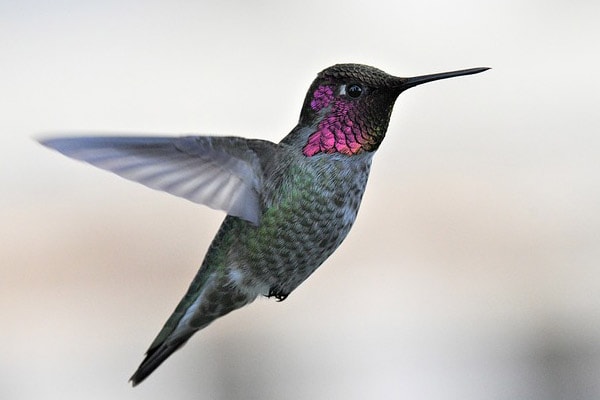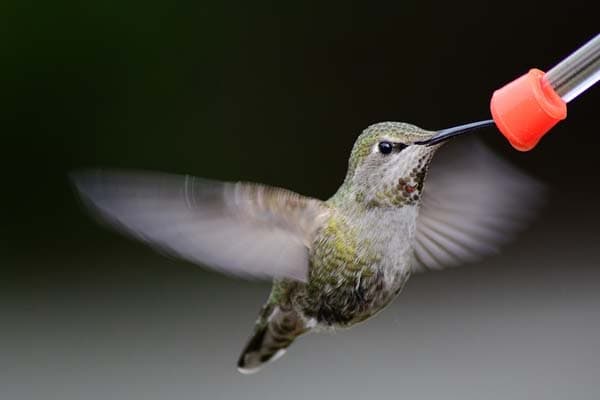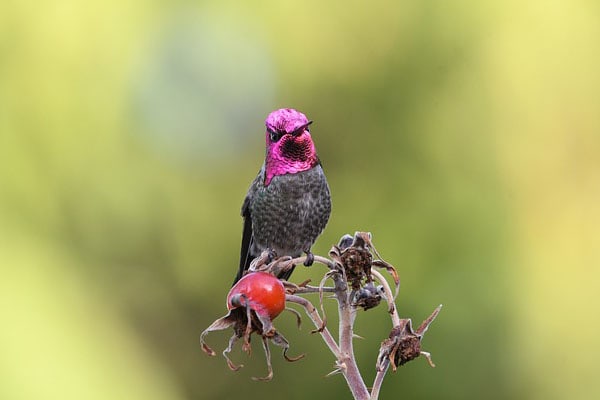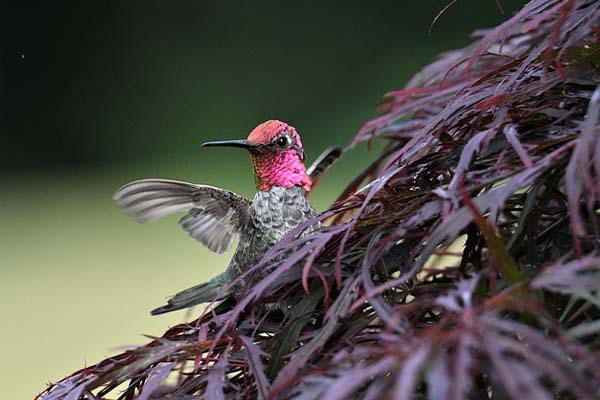Contents [show]
Anna’s hummingbird, better known scientifically as Calypte anna, is a mainstay throughout the western portion of the United States of America. It’s also a member of the Trochilidae family. This gorgeous Hummingbird is a well-known species found along the Pacific coast. It particularly stands out because it indulges in impressive aerial displays, and it has beautiful vibrant plumage.
This bird is particularly cherished for its unique behaviors and beauty. In fact, it was named after the Duchess of Rivoli, Anna Massena, because she fell in love with this diminutive creature.
Typically, the adult males of the members of the species with the most vibrant plumage. The females and immature members of the species tend to have subdued gray-green colors with very little pink on their throats. The males, on the other hand, have a pinkish-red crown and gorget, which is very appealing and vibrant when the light hits it from the right direction.
When compared to other hummingbirds, this bird is medium-sized and typically measures 3.9 to 4.3 inches or 10 to 11 cm in total length. Their bills are short and straight, which makes it very easy to dig inside the heart of a flower to quickly extract the nectar, which is certainly its favorite food source. It also eats other protein-rich foods, including spiders and other insects.
Best of all, Anna’s Hummingbird has had no trouble adapting to human-altered environments. You can find them throughout many suburban areas, including parks, gardens, and other human-made places, just as long as there are plenty of flowering plants in the area that provides their delicious and life-sustaining nectar. In fact, in many regions, they’ll have a year-round presence, which is delightful to nature enthusiasts and bird watchers alike.
- Physical characteristics and descriptive traits of Anna’s hummingbirds
- The biggest differences between female and male Anna’s hummingbirds
- Dietary options, feeding preferences, nesting behaviors, and migration patterns of Anna’s Hummingbird
- Other critical and necessary info about Anna’s hummingbirds
To find out much more about these beautiful diminutive hummingbirds, continue reading below to discover a detailed account of Anna’s hummingbird, including bird identification, habits, facts, nesting, and more.

Anna’s hummingbird facts
- Common Name: Anna’s Hummingbird
- Scientific Name: Calypte Anna
- Scientific Family: Trochilidae
- Life Span: 3-10 years
- Size: 3.9 to 4.3 inches
- Wingspan: 4.7 .0 to 5.5 inches
- Weight: 0.14 to 0.21 oz
- Conservation status: Least Concern
How to Identify an Anna’s hummingbird
Identifying an Anna’s Hummingbird is a lot easier than you think. It possesses certain physical and behavioral characteristics that make this bird stand out. Those key characteristics include the following:
- Size – the size of Anna’s Hummingbird isn’t necessarily distinct because it’s considered a medium-sized Hummingbird. On average, its length is anywhere from 3.9 to 4.3 inches, which equates to 10-11 cm. It may be larger than certain Hummingbird species, but it’s also smaller than others.
- Plumage – the plumage of the adult male Anna’s Hummingbird is very distinctive and really stands out. As far as the crown and throat go, it consists of an iridescent pinkish-red color. Many people describe this color as rose red or magenta. The crown and gorget area appears to look black in color, but this is only when viewed in certain lighting conditions. The body of the adult male Anna’s Hummingbird is greenish-gray in color, but the wings and back have some iridescence. Immature and female members of the species have gray-green feathers and pale throats with specks of pink or red scattered about them.
- Bill & Tail – the bill of Anna’s Hummingbird is straight and relatively short and has a dark color. Their bill was adapted specifically to make it easy to extract nectar from flowers. The tail of this bird is also relatively short, has rounded tips, and it is squared off.
- Behavior – the interesting thing about this bird is that it has very distinctive flight patterns that it exhibits. For starters, it has the ability to hover in midair. It can also fly forward and backward. And its aerial maneuvers are quite quick, to say the least. The male members of the species perform elaborate courtship displays, including rapid diving, soaring high into the air, and they make a buzzing sound while beating their wings.
Difference Between Male & Female

Key differences between male and female Anna’s hummingbirds include:
- Males have vibrant plumage with ruby-red throats and crowns. Females tended to have dull gray-green feathers and pale throats with red or pink speckles scattered within.
- The males tend to be slightly larger in size when compared to females because they usually weigh a little more. But as far as height goes, the two have similar measurements.
- Females are responsible for nesting activities, including raising their young and incubating the eggs, while males perform elaborate courtship displays.
Differences in Summer Plumage vs. Winter Plumage
There aren’t any notable changes in the coloration of the plumage of Anna’s hummingbirds. In fact, male and female members of this species tend to maintain consistent colorations and patterns, respectively, no matter what season it happens to be.
Where You’ll See Anna’s hummingbirds
Primarily, you can easily find Anna’s hummingbirds in the western portion of North America. To get even more specific, they really love hanging around the Pacific Coast in the United States. Some of the common regions and habitats to find these beautiful diminutive creatures include:
- Coastal Regions – these birds can frequently be found along southern Alaska, Washington, Oregon, and California in their coastal areas. They tend to inhabit natural habitats and urban habitats as long as they are found along the coast.
- Parks and Gardens – these medium-sized hummingbirds tend to love the beautiful flowers and attractive plants found in parks and gardens throughout North America. They love feeding on nectar because it’s their favorite food source, and they feel that it tastes delicious. That’s why they tend to easily be found in these areas because there is an abundance of suitable floral resources throughout these landscapes.
- Woodland Edges – you’ll also find Anna’s Hummingbirds along the edge of many woodlands because they love open spaces, but they also love to have a mix of trees to take shelter and nest in. For the most part, you aren’t going to find them buried in land within the forest, but you will find them along the edge with lots of available flowering plants in the region.
- Suburban Areas – they’ll happily gravitate toward suburban areas because they do not mind living in suburban neighborhoods or environments that were altered by humans, like other birds that do not want their habitats disturbed. They have no problem being in suburban areas as long as there are suitable nesting places in flowering plants to gain sustenance from.
- Coastal Redwood Forests – they like this region in particular because the coastal Redwood forests provide open spaces and flowering plants, which is their preferred overall habitat. Plus, they seem to love being relatively close to the water as well.
Anna’s hummingbird Migration Patterns
For the most part, Anna’s Hummingbird doesn’t exhibit much migratory behavior. For all intents and purposes, these birds are mostly non-migratory. Yet, we’ve observed that they are known to move and disperse throughout a very typical range.
For example, these birds remain in their typical breeding territories all year round. This territory is found in the western part of North America, beginning in southern Alaska and going all the way to northern Baja, California, and Mexico. Throughout these regions, some birds might move short distances along with changing environmental conditions. Plus, they may need to get up and move because food sources are no longer readily available.
Diet and Feeding Preferences
Anna’s hummingbird diet is mainly made up of the nectar that they consume from flowering plants. These birds are nectarivorous, meaning their main source of nutrition comes from energy-rich nectar. But it isn’t the only source of calories in their diet.
Anna’s hummingbird loves to get nectar from certain types of plant life. In particular, the flowers and plants that they prefer the most include fuchsia, penstemon, and salvia, since their nectar sources are easily accessible to these birds.
In fact, these birds also get calories from insects and spiders. In particular, they can catch these bugs while hovering in the air or in the midst of short flights. They provide essential nutrients, amino acids, and proteins that help supplement and support the energy levels of these fast-flying birds that consume massive calories in accordance with their body weight.

Anna’s hummingbird nesting
- Clutch Size: 1-3 eggs
- # of Broods: 2-3 broods
- Incubation Period: 14-19 days
- Nesting period: 20-25 days
- Egg Description: White
As far as nesting is concerned, Anna’s hummingbirds will construct a delicate cup-shaped nest in locations that are sheltered and strategically placed to keep them concealed from possible predators.
When it comes to constructing their nest, the female is responsible for this job. She will build her nest using fine materials, including spider silk, lichens, moss, and plant fibers. The nest is woven with these materials to create a cup-shaped structure that’s typically attached horizontally to a twig or branch. She will use materials like moss and lichen to camouflage the nest and keep it safe and protected from predators.
More than likely, you’ll find Anna’s Hummingbird nest in a well-concealed location with lots of trees, shrubs, and dense vegetation surrounding it. She will even build her nest on man-made structures, including clotheslines and eaves. In particular, the nest location is picked in an area that will provide protection from stormy weather conditions and predators.
Upon mating, the female will incubate her eggs for 14-19 days. After the eggs hatch, she cares for her nestlings and feeds them with regurgitated nectar, and she also keeps them safe. These baby fledgling hummingbirds will remain with their parents for about three weeks or more, depending on how long it takes them to reach physical maturity.
The fledgling hummingbirds will leave the nest after they’ve developed their flight feathers. They begin exploring their surroundings, yet their mother still provides them with food and guidance during this important time in their life.
Anna’s hummingbird Behavior
This bird displays certain fascinating behaviors and exhibits characteristics that include the following:
- Flight Abilities – this bird can fly exceptionally and hover in midair, rapidly flap its wings, and it can even feed out of flowers in the midst of flight. It can also fly sideways, forwards, and backward and perform difficult aerial maneuvers.
- Courtship Displays – during courtship, male Anna’s hummingbirds will perform elaborate displays in an effort to attract females. They involve soaring high into the air, steeply diving down toward the ground, flapping their wings, and making a distinctive buzzing sound. They can perform zigzag flights as well.
- Territorial Behavior – male and female Anna’s hummingbirds are very territorial. The males establish the territory and defend it aggressively. They chase away potential intruders when necessary.
- Feeding – Anna’s hummingbirds like to feed on nectar from flowering plants, which they get to with their long, extendable tongues, which they use to lap up the nectar deep inside of their favorite flowers. They can catch small insects and spiders out of midair as well to meet their protein requirements.
- Bathing – these hummingbirds love to keep their feathers clean and in great condition. They will find birdbaths, puddles, or other shallow water sources, which they’ll use to keep themselves clean by rapidly fluttering their wings and then preening to shake off the water.
Conservation Status
The conservation status of Anna’s Hummingbird is currently assessed at Least Concern. This means these birds are not in immediate danger, and they aren’t facing extinction or immediate threats to their survival.
Fun & Interesting Facts
- Anna’s Hummingbird is one of the most common and well-known Hummingbird species in all of North America.
- These birds do not mind eating from bird feeders. They prefer Hummingbird feeders that provide nectar, which is their favorite way to consume energy.
- When compared to other hummingbirds, Anna’s Hummingbird tends to handle cold temperatures better than other members of their species. They enter a state of torpor, which slows down their metabolic rate, helps them conserve energy, and allows them to withstand and survive freezing temperatures at night.
- Even though they are very small birds, Anna’s Hummingbird has a relatively long life span when compared to other hummingbirds. They live anywhere from 3-10 years, which is quite a long time for these birds.
- This bird possesses unique flying abilities. It can fly forward, backward, side to side, and upside down.
Explore More Species in This Family
- Ruby-throated Hummingbird (Archilochus colubris)
- Rufous Hummingbird (Selasphorus rufus)
- Broad-tailed Hummingbird (Selasphorus platycercus)
- Costa’s Hummingbird (Calypte costae)
- Allen’s Hummingbird (Selasphorus sasin)
- Black-chinned Hummingbird (Archilochus alexandri)
- Blue-throated Hummingbird (Lampornis clemenciae)
- Calliope Hummingbird (Selasphorus calliope)
- Cinnamon Hummingbird (Amazilia rutila)
- Green-breasted Mango (Anthracothorax prevostii)
- Long-billed Hermit (Phaethornis longirostris)
- Magnificent Hummingbird (Eugenes fulgens)
- Violet Sabrewing (Campylopterus hemileucurus)
- White-necked Jacobin (Florisuga mellivora)
- White-tailed Goldenthroat (Polytmus guainumbi)
- Xantus’s Hummingbird (Hylocharis xantusii)
- Berylline Hummingbird (Amazilia beryllina)
- Violet-crowned Hummingbird (Amazilia violiceps)
- Buff-bellied Hummingbird (Amazilia yucatanensis)
- Snowcap (Microchera albocoronata)
- Long-tailed Sylph (Aglaiocercus kingii)
- Plain-capped Starthroat (Heliomaster constantii)
- Sparkling Violetear (Colibri coruscans)
- Brazilian Ruby (Clytolaema rubricauda)
- Fiery-throated Hummingbird (Panterpe insignis)
- Black-throated Mango (Anthracothorax nigricollis)
- Long-tailed Hummingbird (Rhamphomicron longicauda)
- Purple-crowned Fairy (Heliothryx barroti)
- Green Thorntail (Discosura conversii)
- Violet-headed Hummingbird (Klais guimeti)
- Amethyst Woodstar (Calliphlox amethystina)
- Bronze-tailed Plumeleteer (Chalybura urochrysia)
- Crowned Woodnymph (Thalurania colombica)
- Gorgeted Woodstar (Chaetocercus heliodor)
- White-bellied Woodstar (Chaetocercus mulsant)
- Little Woodstar (Chaetocercus bombus)
- Red-billed Streamertail (Trochilus polytmus)
- Black-crested Coquette (Lophornis helenae)
- White-vented Plumeleteer (Chalybura buffonii)
- Black-breasted Puffleg (Eriocnemis nigrivestis)
- Ruby-topaz Hummingbird (Chrysolampis mosquitus)
- Shining Sunbeam (Aglaeactis cupripennis)
- Ecuadorian Hillstar (Oreotrochilus chimborazo)
- Booted Racket-tail (Ocreatus underwoodii)

